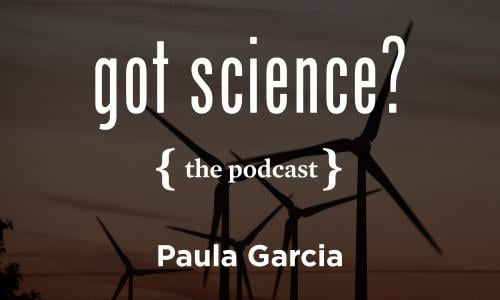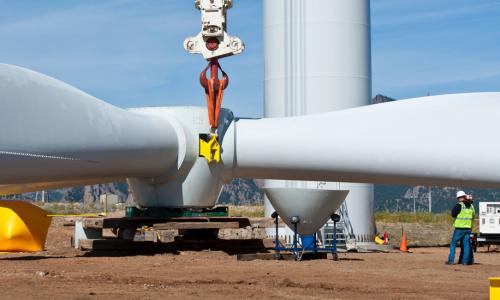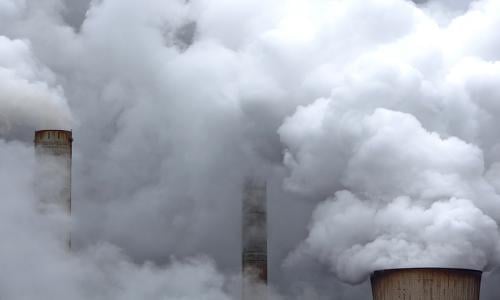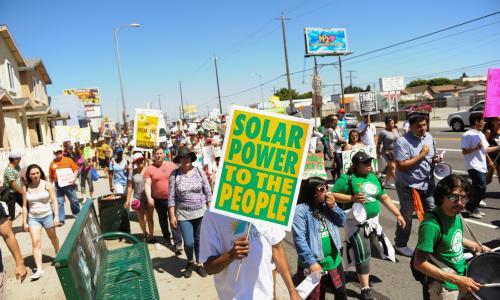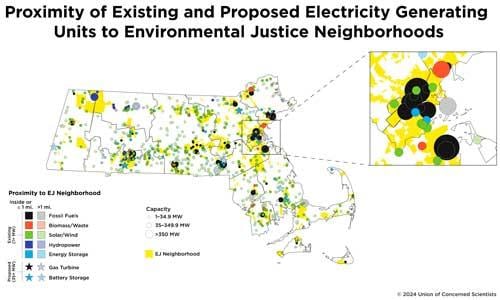Table of Contents
Wind turbines and solar panels are an increasingly common sight. But why? What are the benefits of renewable energies—and how do they improve our health, environment, and economy?
This page explores the many positive impacts of clean energy, including the benefits of wind, solar, geothermal, hydroelectric, and biomass. For more information on their negative impacts—including effective solutions to avoid, minimize, or mitigate—see our page on The Environmental Impacts of Renewable Energy Technologies.
Less global warming
Human activity is overloading our atmosphere with carbon dioxide and other global warming emissions. These gases act like a blanket, trapping heat. The result is a web of significant and harmful impacts, from stronger, more frequent storms, to drought, sea level rise, and extinction.
In the United States, about 29 percent of global warming emissions come from our electricity sector. Most of those emissions come from fossil fuels like coal and natural gas [1, 2].
What is CO2e?
Carbon dioxide (CO2) is the most prevalent greenhouse gas, but other air pollutants—such as methane—also cause global warming. Different energy sources produce different amounts of these pollutants. To make comparisons easier, we use a carbon dioxide equivalent, or CO2e—the amount of carbon dioxide required to produce an equivalent amount of warming.
In contrast, most renewable energy sources produce little to no global warming emissions. Even when including “life cycle” emissions of clean energy (ie, the emissions from each stage of a technology’s life—manufacturing, installation, operation, decommissioning), the global warming emissions associated with renewable energy are minimal [3].
The comparison becomes clear when you look at the numbers. Burning natural gas for electricity releases between 0.6 and 2 pounds of carbon dioxide equivalent per kilowatt-hour (CO2E/kWh); coal emits between 1.4 and 3.6 pounds of CO2E/kWh. Wind, on the other hand, is responsible for only 0.02 to 0.04 pounds of CO2E/kWh on a life-cycle basis; solar 0.07 to 0.2; geothermal 0.1 to 0.2; and hydroelectric between 0.1 and 0.5.
Renewable electricity generation from biomass can have a wide range of global warming emissions depending on the resource and whether or not it is sustainably sourced and harvested.
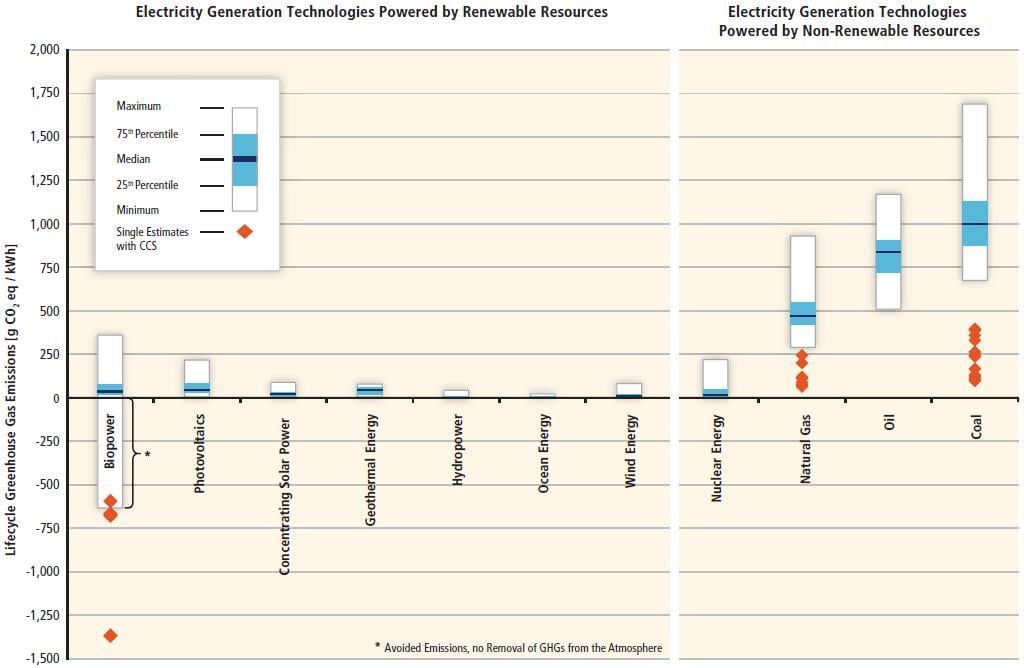
Increasing the supply of renewable energy would allow us to replace carbon-intensive energy sources and significantly reduce US global warming emissions.
For example, a 2009 UCS analysis found that a 25 percent by 2025 national renewable electricity standard would lower power plant CO2 emissions 277 million metric tons annually by 2025—the equivalent of the annual output from 70 typical (600 MW) new coal plants [4].
In addition, a ground-breaking study by the US Department of Energy's National Renewable Energy Laboratory (NREL) explored the feasibility of generating 80 percent of the country’s electricity from renewable sources by 2050. They found that renewable energy could help reduce the electricity sector’s emissions by approximately 81 percent [5].
Improved public health
The air and water pollution emitted by coal and natural gas plants is linked with breathing problems, neurological damage, heart attacks, cancer, premature death, and a host of other serious problems. The pollution affects everyone: one Harvard University study estimated the life cycle costs and public health effects of coal to be an estimated $74.6 billion every year. That’s equivalent to 4.36 cents per kilowatt-hour of electricity produced—about one-third of the average electricity rate for a typical US home [6].
Most of these negative health impacts come from air and water pollution that clean energy technologies simply don’t produce. Wind, solar, and hydroelectric systems generate electricity with no associated air pollution emissions. Geothermal and biomass systems emit some air pollutants, though total air emissions are generally much lower than those of coal- and natural gas-fired power plants.
In addition, wind and solar energy require essentially no water to operate and thus do not pollute water resources or strain supplies by competing with agriculture, drinking water, or other important water needs. In contrast, fossil fuels can have a significant impact on water resources: both coal mining and natural gas drilling can pollute sources of drinking water, and all thermal power plants, including those powered by coal, gas, and oil, withdraw and consume water for cooling.
Biomass and geothermal power plants, like coal- and natural gas-fired power plants, may require water for cooling. Hydroelectric power plants can disrupt river ecosystems both upstream and downstream from the dam. However, NREL's 80-percent-by-2050 renewable energy study, which included biomass and geothermal, found that total water consumption and withdrawal would decrease significantly in a future with high renewables [7].
Inexhaustible energy
Strong winds, sunny skies, abundant plant matter, heat from the earth, and fast-moving water can each provide a vast and constantly replenished supply of energy. A relatively small fraction of US electricity currently comes from these sources, but that could change: studies have repeatedly shown that renewable energy can provide a significant share of future electricity needs, even after accounting for potential constraints [9].
In fact, a major government-sponsored study found that clean energy could contribute somewhere between three and 80 times its 2013 levels, depending on assumptions [8]. And the previously mentioned NREL study found that renewable energy could comfortably provide up to 80 percent of US electricity by 2050.
Jobs and other economic benefits
Compared with fossil fuel technologies, which are typically mechanized and capital intensive, the renewable energy industry is more labor intensive. Solar panels need humans to install them; wind farms need technicians for maintenance.
This means that, on average, more jobs are created for each unit of electricity generated from renewable sources than from fossil fuels.
Renewable energy already supports thousands of jobs in the United States. In 2016, the wind energy industry directly employed over 100,000 full-time-equivalent employees in a variety of capacities, including manufacturing, project development, construction and turbine installation, operations and maintenance, transportation and logistics, and financial, legal, and consulting services [10]. More than 500 factories in the United States manufacture parts for wind turbines, and wind power project installations in 2016 alone represented $13.0 billion in investments [11].
Other renewable energy technologies employ even more workers. In 2016, the solar industry employed more than 260,000 people, including jobs in solar installation, manufacturing, and sales, a 25% increase over 2015 [12]. The hydroelectric power industry employed approximately 66,000 people in 2017 [13]; the geothermal industry employed 5,800 people [14].
Increased support for renewable energy could create even more jobs. The 2009 Union of Concerned Scientists study of a 25-percent-by-2025 renewable energy standard found that such a policy would create more than three times as many jobs (more than 200,000) as producing an equivalent amount of electricity from fossil fuels [15].
In contrast, the entire coal industry employed 160,000 people in 2016 [26].
In addition to the jobs directly created in the renewable energy industry, growth in clean energy can create positive economic “ripple” effects. For example, industries in the renewable energy supply chain will benefit, and unrelated local businesses will benefit from increased household and business incomes [16].
Local governments also benefit from clean energy, most often in the form of property and income taxes and other payments from renewable energy project owners. Owners of the land on which wind projects are built often receive lease payments ranging from $3,000 to $6,000 per megawatt of installed capacity, as well as payments for power line easements and road rights-of-way. They may also earn royalties based on the project’s annual revenues. Farmers and rural landowners can generate new sources of supplemental income by producing feedstocks for biomass power facilities.
UCS analysis found that a 25-by-2025 national renewable electricity standard would stimulate $263.4 billion in new capital investment for renewable energy technologies, $13.5 billion in new landowner income from? biomass production and/or wind land lease payments, and $11.5 billion in new property tax revenue for local communities [17].
Stable energy prices
Renewable energy is providing affordable electricity across the country right now, and can help stabilize energy prices in the future.
Although renewable facilities require upfront investments to build, they can then operate at very low cost (for most clean energy technologies, the “fuel” is free). As a result, renewable energy prices can be very stable over time.
Moreover, the costs of renewable energy technologies have declined steadily, and are projected to drop even more. For example, the average price to install solar dropped more than 70 percent between 2010 and 2017 [20]. The cost of generating electricity from wind dropped 66 percent between 2009 and 2016 [21]. Costs will likely decline even further as markets mature and companies increasingly take advantage of economies of scale.
In contrast, fossil fuel prices can vary dramatically and are prone to substantial price swings. For example, there was a rapid increase in US coal prices due to rising global demand before 2008, then a rapid fall after 2008 when global demands declined [23]. Likewise, natural gas prices have fluctuated greatly since 2000 [25].
Using more renewable energy can lower the prices of and demand for natural gas and coal by increasing competition and diversifying our energy supplies. And an increased reliance on renewable energy can help protect consumers when fossil fuel prices spike.
Reliability and resilience
Wind and solar are less prone to large-scale failure because they are distributed and modular. Distributed systems are spread out over a large geographical area, so a severe weather event in one location will not cut off power to an entire region. Modular systems are composed of numerous individual wind turbines or solar arrays. Even if some of the equipment in the system is damaged, the rest can typically continue to operate.
For example, Hurricane Sandy damaged fossil fuel-dominated electric generation and distribution systems in New York and New Jersey and left millions of people without power. In contrast, renewable energy projects in the Northeast weathered Hurricane Sandy with minimal damage or disruption [25].
Water scarcity is another risk for non-renewable power plants. Coal, nuclear, and many natural gas plants depend on having sufficient water for cooling, which means that severe droughts and heat waves can put electricity generation at risk. Wind and solar photovoltaic systems do not require water to generate electricity and can operate reliably in conditions that may otherwise require closing a fossil fuel-powered plant. (For more information, see How it Works: Water for Electricity.)
The risk of disruptive events will also increase in the future as droughts, heat waves, more intense storms, and increasingly severe wildfires become more frequent due to global warming—increasing the need for resilient, clean technologies.
[1] Environmental Protection Agency. 2017. Inventory of U.S. Greenhouse Gas Emissions and Sinks: 1990-2015.
[2] Energy Information Agency (EIA). 2017. How much of the U.S. carbon dioxide emissions are associated with electricity generation?
[3] Intergovernmental Panel on Climate Change (IPCC). 2011. IPCC Special Report on Renewable Energy Sources and Climate Change Mitigation. Prepared by Working Group III of the Intergovernmental Panel on Climate Change [O. Edenhofer, R. Pichs-Madruga, Y. Sokona, K. Seyboth, P. Matschoss, S. Kadner, T. Zwickel, P. Eickemeier, G. Hansen, S. Schlömer, C. von Stechow (eds)]. Cambridge University Press, Cambridge, United Kingdom and New York, NY, USA, 1075 pp. (Chapter 9).
[4] Union of Concerned Scientists (UCS). 2009. Clean Power Green Jobs.
[5] National Renewable Energy Laboratory (NREL). 2012. Renewable Electricity Futures Study. Volume 1, pg. 210.
[6] Epstein, P.R.,J. J. Buonocore, K. Eckerle, M. Hendryx, B. M. Stout III, R. Heinberg, R. W. Clapp, B. May, N. L. Reinhart, M. M. Ahern, S. K. Doshi, and L. Glustrom. 2011. Full cost accounting for the life cycle of coal in “Ecological Economics Reviews.” Ann. N.Y. Acad. Sci. 1219: 73–98.
[7] Renewable Electricity Futures Study. 2012.
[8] NREL. 2016. Estimating Renewable Energy Economic Potential in the United States: Methodology and Initial Results.
[9] Renewable Electricity Futures Study. 2012.
IPCC Special Report on Renewable Energy Sources and Climate Change Mitigation. Prepared by Working Group III of the Intergovernmental Panel on Climate Change. 2011.
UCS. 2009. Climate 2030: A national blueprint for a clean energy economy.
[10] American Wind Energy Association (AWEA). 2017. AWEA U.S. Wind Industry Annual Market Report: Year Ending 2016. Washington, D.C.: American Wind Energy Association.
[11] Wiser, Ryan, and Mark Bolinger. 2017. 2016 Wind Technologies Market Report. U.S. Department of Energy.
[12] The Solar Foundation. 2017. National Solar Jobs Census 2016.
[13] Navigant Consulting. 2009. Job Creation Opportunities in Hydropower.
[14] Geothermal Energy Association. 2010. Green Jobs through Geothermal Energy.
[15] UCS. 2009. Clean Power Green Jobs.
[16] Environmental Protection Agency. 2010. Assessing the Multiple Benefits of Clean Energy: A Resource for States. Chapter 5.
[17] UCS. 2009. Clean Power Green Jobs.
[18] Deyette, J., and B. Freese. 2010. Burning coal, burning cash: Ranking the states that import the most coal. Cambridge, MA: Union of Concerned Scientists.
[20] SEIA. 2017. Solar Market Insight Report 2017 Q2.
[21] AWEA. 2017. AWEA U.S. Wind Industry Annual Market Report: Year Ending 2016. Washington, D.C.: American Wind Energy Association.
[22] UCS. 2009. Clean Power Green Jobs.
[23] UCS. 2011. A Risky Proposition: The financial hazards of new investments in coal plants.
[24] EIA. 2013. U.S. Natural Gas Wellhead Price.
[25] Unger, David J. 2012. Are renewables stormproof? Hurricane Sandy tests solar, wind. The Christian Science Monitor. November 19.
[26] Department of Energy. 2017 U.S. Energy and Employment Report

